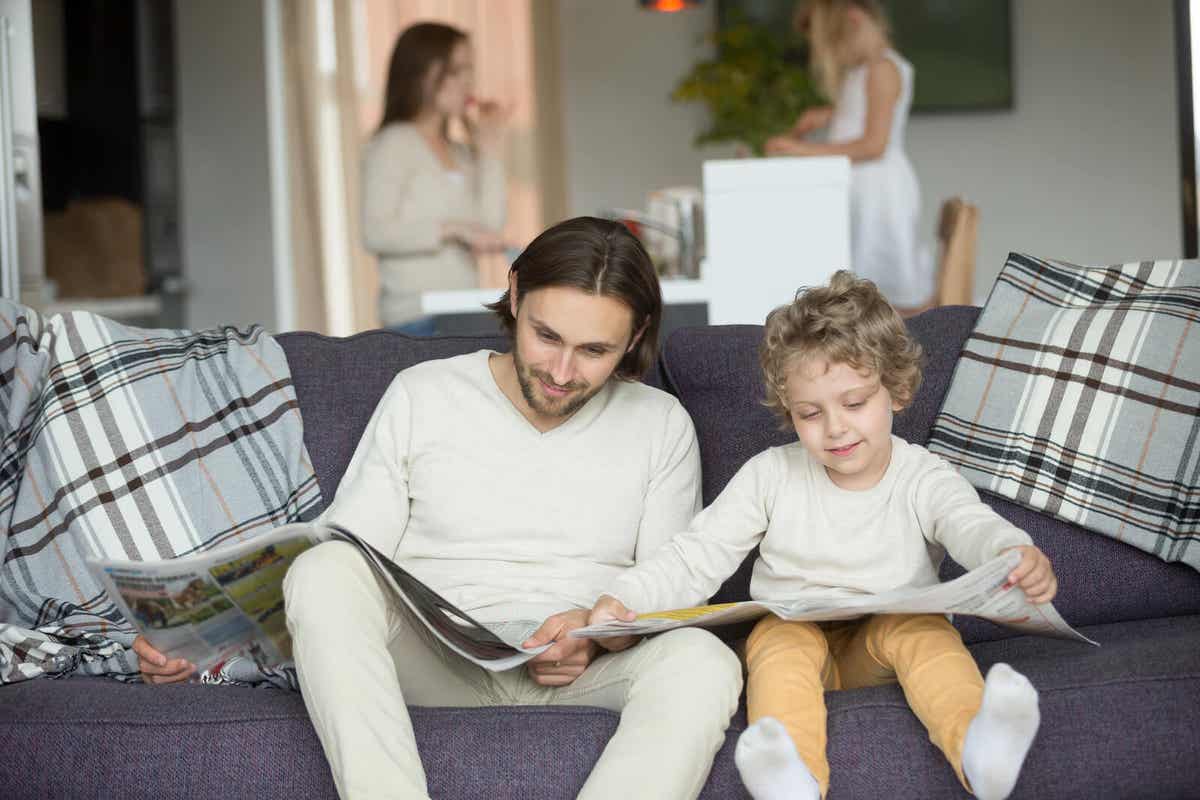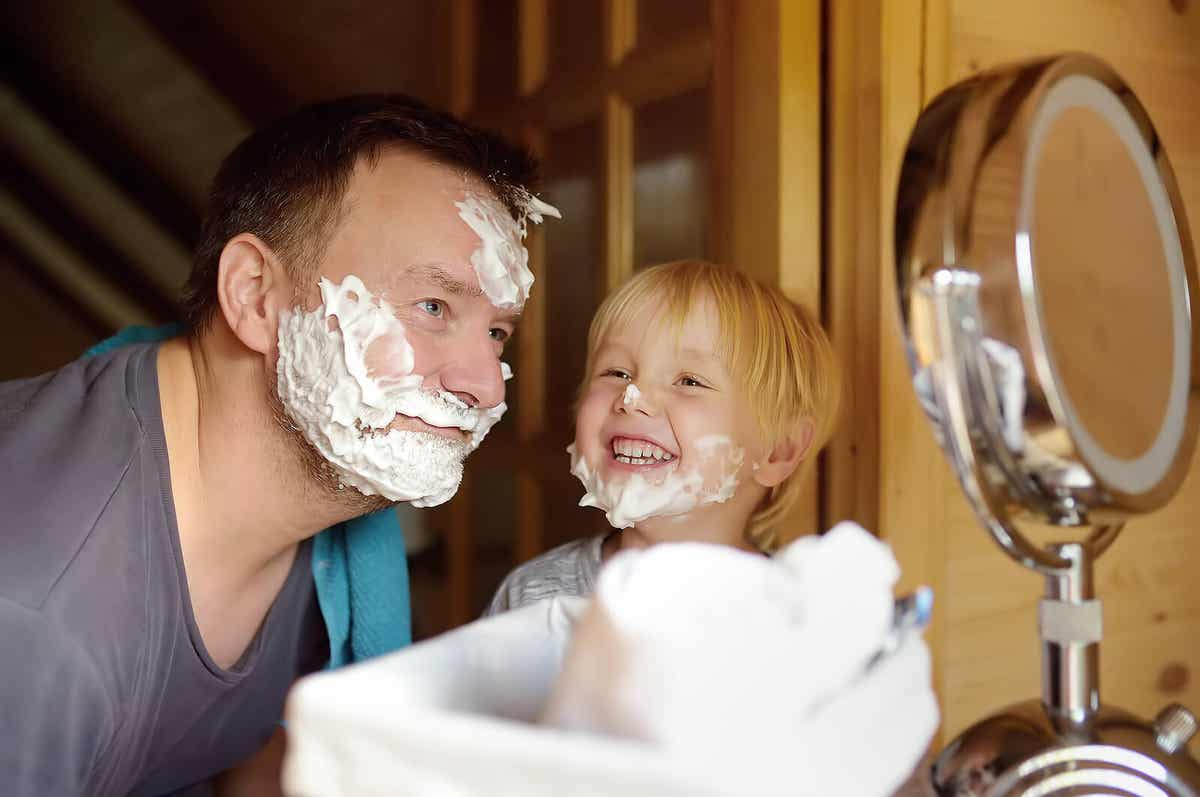What is Observational Learning?

Albert Bandura, Canadian psychologist and pedagogue, is the forerunner and main representative of the social theory of learning. His theory tells us that we all learn unconsciously and implicitly from the moment we’re born. We do this through observational learning. Do you want to know how this happens?
Observation, one of the earliest forms of learning
Learning involves a continuous and permanent change in our behavior. When we learn, we acquire knowledge and skills, and we do it through experience, study, observation, and practice.
Well, observational learning is one of the earliest and most important forms of learning that children do from birth. From a very young age, infants learn and modify patterns of behaviors, knowledge, and attitudes by watching adults.
“Fortunately, most of human behavior is learned by observation through modeling.”
-Bandura, 1987-

They treat their parents, teachers, friends, and television heroes as models. Then, when they see how another person behaves, they change their own behavior.
We just have to look at how our children imitate many of our behaviors. How we dress, how we wash or comb our hair, and even if we yell, because they’re always watching and learning from us.
Therefore, we must be examples of education for our children and for our students. We’re their reference points and their teachers. We’re examples who continuously act in front of them and, therefore, they’ll imitate us, whether our behavior is good or bad.
However, kids don’t learn everything they see in a social environment, as these behaviors depend on several factors. For example, these are:
- Complexity of the model to be imitated
- Child’s cognitive ability
- Importance of the adult to the child
- Functional value of the modeled behavior
The advantages of observational learning
Research regarding the observational learning process indicates that this type of learning:
- Develops the acquisition of new behaviors and attitudes
- Modifies previously learned behaviors, either strengthening or weakening them
- Promotes current behavior that children learned previously
- Answers questions they have and seeing how others respond
- Directs their attention
- Wakens and activates their emotions
However, these effects depend on cognitive factors like attention, retention, and the ability to reproduce behavior and motivation.
“By observing the behavior of others and the consequences of their responses, the observer can learn new responses or vary the characteristics of the previous responses, without executing any overt response or receiving any direct reinforcement. In some cases, the observer can, in fact, learn as much as the performer.”
-Bandura and Walters-
The processes involved in learning through observation
As we’ve mentioned, Albert Bandura considers the behaviors of other people to have an essential influence on learning and how one forms their own behavior. However, some complex behaviors can only be learned through modeling or examples from other people.
That is, it’s about putting the child in contact with valid and appropriate models so they can imitate them or learn from them. By learning through observation, Bandura establishes four consecutive processes.
Attention
As we all know, to learn, you need to pay attention. Any element that distracts you also stops you from learning. So, if a child is sick, has problems at home, has ADHD, or is simply distracted by any stimulus, learning will decrease.
At the same time, role models also influence attention. If the model is colorful, attractive, and appears competent, the child will pay more attention. Also, if the model looks more like them, they’ll pay even more attention.

Retention
We need to be able to remember what we’ve paid attention to. To remember, it’s important to save mental images that we’ve seen the model do. That is, the child must activate their long-term memory and remember what they saw. If the kid hasn’t paid attention, they won’t remember what they’ve seen. Therefore, they won’t be able to imitate it later.
Reproduction
As we’ve mentioned, we have to be able to reproduce the behavior. Keep in mind that our ability to imitate improves with practice.
Motivation
Even if we’re willing to pay attention, retain and reproduce, if we aren’t motivated, we won’t learn anything. For kids, motivation arises when they see that another kid gets a reward or praise for doing or not doing something. This way, kids will want to repeat the behavior or avoid it.
Things to keep in mind about observational learning
Many of children’s behaviors are learned indirectly. They do this through observation and symbolic representation of other people and situations. Therefore, their role models, in this case, family and teachers, play a fundamental role in shaping our kids’ behaviors.
We must be good role models. If we’re aggressive, they will be too. If we scream, they scream too. Therefore, if our children have aggressive behaviors, most of the fault will be ours, because they’re imitating us. If, on the contrary, they see us with a positive and calm attitude, children will learn to be that way. Children learn what they see.
Albert Bandura, Canadian psychologist and pedagogue, is the forerunner and main representative of the social theory of learning. His theory tells us that we all learn unconsciously and implicitly from the moment we’re born. We do this through observational learning. Do you want to know how this happens?
Observation, one of the earliest forms of learning
Learning involves a continuous and permanent change in our behavior. When we learn, we acquire knowledge and skills, and we do it through experience, study, observation, and practice.
Well, observational learning is one of the earliest and most important forms of learning that children do from birth. From a very young age, infants learn and modify patterns of behaviors, knowledge, and attitudes by watching adults.
“Fortunately, most of human behavior is learned by observation through modeling.”
-Bandura, 1987-

They treat their parents, teachers, friends, and television heroes as models. Then, when they see how another person behaves, they change their own behavior.
We just have to look at how our children imitate many of our behaviors. How we dress, how we wash or comb our hair, and even if we yell, because they’re always watching and learning from us.
Therefore, we must be examples of education for our children and for our students. We’re their reference points and their teachers. We’re examples who continuously act in front of them and, therefore, they’ll imitate us, whether our behavior is good or bad.
However, kids don’t learn everything they see in a social environment, as these behaviors depend on several factors. For example, these are:
- Complexity of the model to be imitated
- Child’s cognitive ability
- Importance of the adult to the child
- Functional value of the modeled behavior
The advantages of observational learning
Research regarding the observational learning process indicates that this type of learning:
- Develops the acquisition of new behaviors and attitudes
- Modifies previously learned behaviors, either strengthening or weakening them
- Promotes current behavior that children learned previously
- Answers questions they have and seeing how others respond
- Directs their attention
- Wakens and activates their emotions
However, these effects depend on cognitive factors like attention, retention, and the ability to reproduce behavior and motivation.
“By observing the behavior of others and the consequences of their responses, the observer can learn new responses or vary the characteristics of the previous responses, without executing any overt response or receiving any direct reinforcement. In some cases, the observer can, in fact, learn as much as the performer.”
-Bandura and Walters-
The processes involved in learning through observation
As we’ve mentioned, Albert Bandura considers the behaviors of other people to have an essential influence on learning and how one forms their own behavior. However, some complex behaviors can only be learned through modeling or examples from other people.
That is, it’s about putting the child in contact with valid and appropriate models so they can imitate them or learn from them. By learning through observation, Bandura establishes four consecutive processes.
Attention
As we all know, to learn, you need to pay attention. Any element that distracts you also stops you from learning. So, if a child is sick, has problems at home, has ADHD, or is simply distracted by any stimulus, learning will decrease.
At the same time, role models also influence attention. If the model is colorful, attractive, and appears competent, the child will pay more attention. Also, if the model looks more like them, they’ll pay even more attention.

Retention
We need to be able to remember what we’ve paid attention to. To remember, it’s important to save mental images that we’ve seen the model do. That is, the child must activate their long-term memory and remember what they saw. If the kid hasn’t paid attention, they won’t remember what they’ve seen. Therefore, they won’t be able to imitate it later.
Reproduction
As we’ve mentioned, we have to be able to reproduce the behavior. Keep in mind that our ability to imitate improves with practice.
Motivation
Even if we’re willing to pay attention, retain and reproduce, if we aren’t motivated, we won’t learn anything. For kids, motivation arises when they see that another kid gets a reward or praise for doing or not doing something. This way, kids will want to repeat the behavior or avoid it.
Things to keep in mind about observational learning
Many of children’s behaviors are learned indirectly. They do this through observation and symbolic representation of other people and situations. Therefore, their role models, in this case, family and teachers, play a fundamental role in shaping our kids’ behaviors.
We must be good role models. If we’re aggressive, they will be too. If we scream, they scream too. Therefore, if our children have aggressive behaviors, most of the fault will be ours, because they’re imitating us. If, on the contrary, they see us with a positive and calm attitude, children will learn to be that way. Children learn what they see.
All cited sources were thoroughly reviewed by our team to ensure their quality, reliability, currency, and validity. The bibliography of this article was considered reliable and of academic or scientific accuracy.
- Ruiza, M., Fernández, T. y Tamaro, E. (2004). Biografia de Albert Bandura. En Biografías y Vidas. La enciclopedia biográfica en línea. Barcelona (España).
- Gómez, Á. R. (1990). La teoría cognitiva social del aprendizaje: Implicaciones educativas. In Desarrollo psicológico y educación (pp. 69-80). Alianza.
This text is provided for informational purposes only and does not replace consultation with a professional. If in doubt, consult your specialist.








